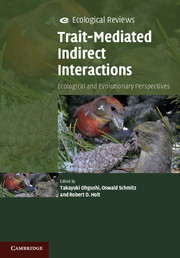Book contents
- Frontmatter
- Contents
- Contributors
- Foreword
- Preface
- Chapter One Introduction
- Part I Community
- Part II Coevolution
- Part III Ecosystem
- Chapter Sixteen Perspective
- Chapter Seventeen Species functional traits, trophic control and the ecosystem consequences of adaptive foraging in the middle of food chains
- Chapter Eighteen Effects of herbivores on terrestrial ecosystem processes
- Chapter Nineteen Functional and heritable consequences of plant genotype on community composition and ecosystem processes
- Chapter Twenty Microbial mutualists and biodiversity in ecosystems
- Chapter Twenty-One Integrating trait-mediated effects and non-trophic interactions in the study of biodiversity and ecosystem functioning
- Part IV Applied Ecology
- Index
- Plate Section
- References
Chapter Twenty - Microbial mutualists and biodiversity in ecosystems
Published online by Cambridge University Press: 05 February 2013
- Frontmatter
- Contents
- Contributors
- Foreword
- Preface
- Chapter One Introduction
- Part I Community
- Part II Coevolution
- Part III Ecosystem
- Chapter Sixteen Perspective
- Chapter Seventeen Species functional traits, trophic control and the ecosystem consequences of adaptive foraging in the middle of food chains
- Chapter Eighteen Effects of herbivores on terrestrial ecosystem processes
- Chapter Nineteen Functional and heritable consequences of plant genotype on community composition and ecosystem processes
- Chapter Twenty Microbial mutualists and biodiversity in ecosystems
- Chapter Twenty-One Integrating trait-mediated effects and non-trophic interactions in the study of biodiversity and ecosystem functioning
- Part IV Applied Ecology
- Index
- Plate Section
- References
Summary
Defining and detecting microbial trait-mediated indirect interactions
Microbial trait-mediated indirect interactions (TMIIs) occur when a microbe (species A) changes a trait of its host species (species B) that consequently affects another species in the community (species C, or the enemy of the host in a protection mutualism). This trait-mediated effect is distinguished from a density-mediated effect, in which the impact of the microbe would spread to other species exclusively through changes in the density of the host organism (e.g., via increased host mortality caused by a pathogen, density-mediated indirect interactions, DMII). Importantly, models reveal that TMIIs have different dynamical consequences than DMIIs (Chapter 1), thus it is important to distinguish between these effects.
Food web diagrams can bring clarity to the characterization of TMIIs. In contrast to typical predator–prey interactions, microbially-mediated protection mutualisms can involve a microbial partner at the same, or very similar, trophic level as the host organism (Fig. 20.1). Furthermore, symbioses involve the exchange of resources, for example photosynthetic carbon exchanged for soil nutrients in the symbiosis between plants and mycorrhizal fungi; this exchange is depicted explicitly in our diagrams, which include trait-mediated effects that are transmitted to a responding resource species (Fig. 20.1e) or to a consumer species (Fig. 20.1f).
- Type
- Chapter
- Information
- Trait-Mediated Indirect InteractionsEcological and Evolutionary Perspectives, pp. 391 - 413Publisher: Cambridge University PressPrint publication year: 2012
References
- 2
- Cited by

